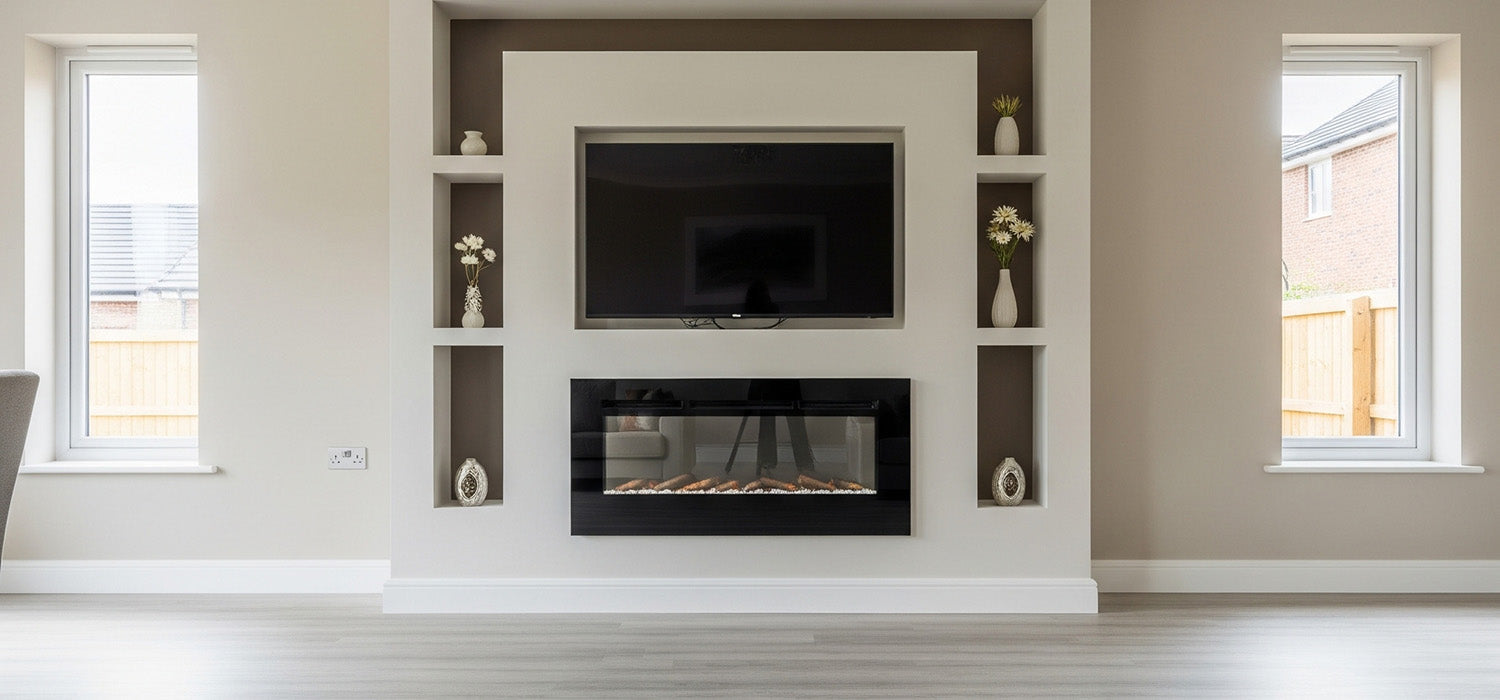
How Deep Should Your Media Wall Be? A Guide to Perfect Fit & Function
How deep should a media wall be? Around 15–30cm—just enough to hide your cables, fit your tech, and still impress the in-laws. Whether you're squeezing in a Media Wall Fire or future-proofing for mega screens, there’s more to depth than meets the eye. Keep reading to get it just right!
Factors Determining Media Wall Depth
TV Depth and Mounting Type
Flat-Panel TVs vs. Older Models
Most modern tellies are slim enough to rival a paperback book, which is great news for anyone wanting a sleek setup. But if you’ve got an older plasma or chunky LED, it’s a different story. Some of those can be twice the depth, and they need more room behind the wall to breathe.
Slim TVs might only need around 50mm–70mm for depth, but it’s the extras—like plugs, power bricks, and stands—that catch people out.
Always measure the full rear profile before assuming it’ll tuck in nicely.
Recessed vs. Flush Mounts
Planning a recessed look, where your TV sits snug inside the wall? Lovely idea—but that does mean carving out more depth. A flush-mounted setup is easier and shallower but can look a bit more “stuck on.”
If you’re going for the built-in aesthetic, you’ll need at least 150mm to 200mm—plus a bit of breathing room behind the screen.
Component Depth (Media Players, Soundbars, Consoles)
Standard Component Sizes
It’s not just the telly to think about. Got a Sky box, PlayStation, or chunky soundbar? Many of these can be 300mm deep once you add cables and connectors.
Stack two of those together and suddenly your media wall needs more room than you expected. Shoving everything in a tight gap might work for socks, but it doesn’t end well with electronics.
Ventilation Requirements for Devices
All those gadgets generate heat—especially when you’re halfway through a box set binge. If air can’t flow, your tech could overheat and cut out.
Leave at least 50mm clearance around devices. Better yet, go for ventilated cabinets or install mesh panels at the back.
Desired Aesthetics and Room Space
Minimalist Look vs. Integrated Storage
If your dream is a clean, hotel-style lounge with floating shelves and sleek lighting, a shallow media wall could do the trick. But if you want to stash DVDs, board games, or a bottle of something behind a door—go deeper.
A Media Wall Fire adds another layer of luxury, but also demands extra depth. Beauty, in this case, does have a price: usually an extra 100–200mm of wall space.
Impact on Room Traffic Flow
Nobody likes bumping into furniture corners in the dark. In narrower rooms or corridors, a deep media wall can become a shin-bashing hazard.
Shallow designs help maintain open walkways and keep things airy. It’s all about the balance between wow-factor and walkability.
Recommended Minimum Depths
For Basic TV Recess Only
Accounting for TV Thickness + Cables
A modern flat-screen TV might be 50mm deep—but with brackets, wall plugs, and HDMI leads, that number balloons quickly.
Typical Minimum: 150mm – 200mm (6–8 inches)
If you’re going for a simple, clean install with no extras, this range works well. It gives just enough depth to keep things tidy without eating into your living space.
For Recessed Components (e.g., Sky Box, Games Console)
Component Depth + Airflow Clearance
Measure the deepest part of each device (not just the casing), then add space for wires and ventilation. Don’t forget: devices like amplifiers and consoles can run hot.
Typical Minimum: 300mm – 400mm (12–16 inches)
This allows you to keep your equipment hidden while still giving it room to function properly—no overheating, no tangles, and no regrets.
For Integrated Electric Fires
Fire Unit Depth + Required Clearances
A Media Wall Fire makes a big impact visually—but be sure to check the install manual. Many require extra space around the unit for airflow and access.
Varies Widely Based on Fire Model
Some ultra-slimline models might only need 150mm, while larger fires with realistic logs and LED effects can go beyond 400mm. Always go by the manufacturer's advice here.
Optimal Depths for Functionality and Aesthetics
Balancing Form and Function
Creating Sufficient Storage Space
Want to hide wires, stash remotes, or keep a tidy shelf for ornaments? You’ll want a depth that supports closed cupboards and open niches without making the wall look like a wardrobe.
Avoiding an Overly Deep or Shallow Look
A media wall should feel like it belongs—not like it’s trying to swallow the room or glued on like an afterthought. Depth between 250–400mm often hits the sweet spot: practical and polished.
Ergonomics for Viewing
Impact on Seating Arrangement
TV too high? You’ll strain your neck. Too low? It’ll feel like you’re in the front row of the cinema.
Your media wall’s depth influences screen position. For most setups, aim for the centre of the screen to be roughly eye-level when seated—about 1050mm off the floor.
Preventing Neck Strain
A media wall done right means you can watch for hours in comfort—no craning, slouching, or pillow-stacking required.
Cable Management and Ventilation
Ensuring Adequate Space for Wiring
Don’t underestimate the jungle of wires behind your setup. HDMI, speaker wires, Ethernet, and power—all need space to bend and move without damaging ports.
Add at least 30–50mm behind every device or channel to run cables neatly.
Promoting Air Circulation
Let your electronics breathe! Overheating can shorten the lifespan of your gear. Use open shelving, vent panels, or fans in enclosed units.
How to Measure and Plan Your Depth
Measuring Your TV and Devices
Take a tape measure to every piece of tech going in. Include plug depth, wire clearance, and ventilation. Round up, not down—your devices won’t shrink to fit.
Creating a Mock-Up or Sketch
Map it out with masking tape on the wall or sketch it on paper. Visualising depth helps avoid awkward builds or design regrets. A cardboard cut-out works wonders.
Considering Existing Wall Obstructions
Before drilling anything, check for sockets, switches, pipes, or beams. Nothing kills a DIY buzz like drilling into a water line.
Pros and Cons of Different Depths
Shallow Media Walls
Pros:
-
Space-saving
-
Cheaper to build
-
Ideal for minimalist designs
Cons:
-
Limited storage
-
Harder to hide components
-
Less room for upgrades
Deep Media Walls
Pros:
-
Plenty of storage
-
Easily fits a Media Wall Fire
-
Future-proof for more tech
Cons:
-
Takes up more space
-
More costly and complex to install
-
Can overpower small rooms
Conclusion: Finding the Perfect Depth for Your Media Wall
Depth might not be the flashiest part of your media wall—but get it wrong, and the whole thing feels off. Whether it’s a simple screen nook or a full-blown home cinema with a Media Wall Fire, your depth decision matters.
Start with your gear, think about your space, and plan for the future. Go too shallow and you’ll struggle to fit your kit. Too deep, and it might dominate the room.
Measure twice, build once—and enjoy a media wall that looks as smart as it performs.
Other content we think you'll love
- Can I Build a Media Wall Myself? A DIY Guide for UK Homes
- How to Build a Stylish Media Wall with TV & Fireplace
- Can You Build a Media Wall Over a Radiator? A Stylish Guide
- Can You Build a Media Wall on Carpet? Tips for a Stable Setup
- Can You Build a Media Wall Around a Fireplace? A Cosy & Stylish Upgrade
- How to Build a Media Wall on a Chimney Breast (UK Guide)
- Can You Build a Media Wall in a Council House? A Practical Guide
- The Ultimate Guide to Buying a Pre-Made Media Wall in the UK
- How to Attach Plasterboard to a Media Wall: A Step-by-Step Guide
- Are Media Wall Fires Safe? What Every UK Homeowner Should Know
- Can You Build a Media Wall Without Plastering?
- How is a Media Wall Built? A Step-by-Step DIY Guide
- MDF vs Plasterboard for Media Walls: Which Should You Choose?
- What Are the Disadvantages of Media Walls? A Cautionary Guide
- What is a Media Wall? The Ultimate Living Room Glow-Up

